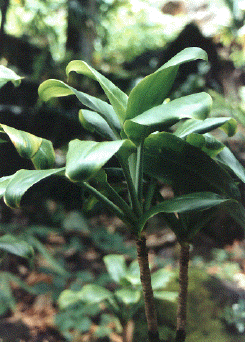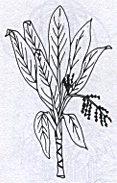Canoe Plants of Ancient Hawai`i Home - Intro - Contents - Bibliography - Links - Credits `Ape - `Awa -`Awapuhi -Hau -Ipu -Kalo -Kamani -Ki -Ko -Kou -Kukui -Mai`a Milo -Niu -Noni -`Ohe -`Ohi`a `Ai -`Olena -Olona -Pia -`Uala -Uhi -`Ulu -Wauke |
Canoe Plants of Ancient Hawai`i Home - Intro - Contents - Bibliography - Links - Credits `Ape - `Awa -`Awapuhi -Hau -Ipu -Kalo -Kamani -Ki -Ko -Kou -Kukui -Mai`a Milo -Niu -Noni -`Ohe -`Ohi`a `Ai -`Olena -Olona -Pia -`Uala -Uhi -`Ulu -Wauke |
 Ki, the Ti plant, grows abundantly, cultivated and wild, throughout the tropical Pacific and Southeast Asia. It is common from sea level in the lower wetlands, up to the 4,000 foot elevation. Ti is found in shady moist gardens, as a landscaping background plant or as a hedge. The people of Hawai`i plant it around their homes and churches for good luck. In the old days Ki was planted around the lo`i, taro ponds. The botanical or scientific name of this member of the lily family is Cordyline terminalis. It may have originated in tropical Asia and Australia.
Ki, the Ti plant, grows abundantly, cultivated and wild, throughout the tropical Pacific and Southeast Asia. It is common from sea level in the lower wetlands, up to the 4,000 foot elevation. Ti is found in shady moist gardens, as a landscaping background plant or as a hedge. The people of Hawai`i plant it around their homes and churches for good luck. In the old days Ki was planted around the lo`i, taro ponds. The botanical or scientific name of this member of the lily family is Cordyline terminalis. It may have originated in tropical Asia and Australia. Introduced to Hawai`i by the earliest Polynesian settlers, Ki is considered sacred to the Hawai`i god Lono and to the goddess of the hula, Laka. It is also an emblem of high rank and divine power. The Hawai`i feather kahili is said to have been inspired by this plant. The leaves are also worn or carried as protection to ward off so-called evil spirits and to call in good. The kahuna priests wore ti leaves either as lei or as garments when they conducted ancient ceremonial rituals. Ti leaves are still used often today in religious ceremonies conducted by Hawai`i's multi-racial clergy, especially at opening ceremonies to bless new buildings and projects.
Introduced to Hawai`i by the earliest Polynesian settlers, Ki is considered sacred to the Hawai`i god Lono and to the goddess of the hula, Laka. It is also an emblem of high rank and divine power. The Hawai`i feather kahili is said to have been inspired by this plant. The leaves are also worn or carried as protection to ward off so-called evil spirits and to call in good. The kahuna priests wore ti leaves either as lei or as garments when they conducted ancient ceremonial rituals. Ti leaves are still used often today in religious ceremonies conducted by Hawai`i's multi-racial clergy, especially at opening ceremonies to bless new buildings and projects.
 The ti's versatile leaves have many uses, including: as wrappings for offerings; for roof thatching; as fly whisks or fans; wrappings for cool food storage, preservation and protection; for wrapping of food to be cooked, especially for laulau; as plates or cups; as fishing lures on hukilau nets; as wearing apparel, such as rain capes, sandals and as hula skirts called pa`u; and, more recently, as feed for cattle and horses. Ti leaves are also decorative; they are braided, twisted or woven into lei for numerous special and celebratory occasions; used as a covering for lu`au tables; and, they provide Hawai`i's tropical flower industry with a wonderful variety of foliage for impressive floral arrangements.
The ti's versatile leaves have many uses, including: as wrappings for offerings; for roof thatching; as fly whisks or fans; wrappings for cool food storage, preservation and protection; for wrapping of food to be cooked, especially for laulau; as plates or cups; as fishing lures on hukilau nets; as wearing apparel, such as rain capes, sandals and as hula skirts called pa`u; and, more recently, as feed for cattle and horses. Ti leaves are also decorative; they are braided, twisted or woven into lei for numerous special and celebratory occasions; used as a covering for lu`au tables; and, they provide Hawai`i's tropical flower industry with a wonderful variety of foliage for impressive floral arrangements.
Ti (pronounced tee) has tall, sparingly branched wood stalks 3 to 12 feet high. The tightly spiraled leaf cluster is in a tuft at the top of the ringed stalk. The plant's green leaves are pointed, oval and blade- shaped, about 4 inches wide and vary from 1 to 2 feet long. As new leaves form at the center, the outside older leaves turn yellow and fall, leaving a circular ring on the plant's stalk. The thick, shiny and flexible leaves do not wilt quickly, making them useful for many purposes, some as already mentioned. Varieties of the ti plant have colored foliage and variously shaped leaves, called lauki, la`i, laki or lau`i. Besides the original and sacred green ki, the plant ranges in leaf color from pale white and yellow with green tones, to reds, covering a broad spectrum from pale to pink to a maroon, that appears almost black.
The plant's flower stalk emerges in winter. With the coming of spring, a many-branched drooping cluster of flowers comes into bloom. Its hundreds of tiny half-inch lilac-whitish purple flowers resemble miniature lilies. White or red berries follow the flowering stage, especially in varieties other than the green.
This versatile plant has many medicinal uses, either alone or as a wrapping for other herbs needing to be steamed or boiled. For fever, the entire body of an unclothed prone person was covered from the neck down with large green ti leaves. After the patient sweat and fever was broken, the leaves were removed. Drinks of fresh water were given to the patient during this process, which took several hours. Cool, freshly washed damp green ti leaves, held and wrapped around the forehead and temples, can be helpful in relieving headache and fever. The center of ti, mole ki, is often picked and unfurled for this use. Hot stones are wrapped in ki leaves and used to soothe sore back muscles.
A drink from boiled green ti leaves is used to aid nerve and muscle relaxation. Steam from boiled young shoots and leaves makes an effective decongestant. The pleasantly fragrant flowers are also used for asthma, when prepared with other plants.
A popular use of this plant was in making Okolehao, affectionately called oke, a potent liquor much like a clear brandy. This brew is distilled from a ferment of baked mashed ti root, a practice being renewed in modern times. The root is thick, white and sweet, growing very large in older plants. The baked roots are also an emergency famine food and have been eaten as a confection.
Children of old Hawai`i (and modern times, too) enjoyed sliding down steep grassy slopes on ti leaf sleds, holding onto the stem towards the front. Whistles can also be made from the plant's leaf.
New plants propagate easily from cuttings and grow best where sunlight and moisture are both available. The stem cutting can be planted vertically for one plant, or horizontally for several.
The ki plant is common, we see and recognize it everywhere throughout this Hawai`i Nei. It is common, yet it is very special. It speaks to us of strength and survival, and the abundance of blessings we receive daily here in Hawai`i.
| Canoe Plants of Ancient Hawai`i Home Intro - Contents - Bibliography - Links - Credits `Ape -`Awa -`Awapuhi -Hau -Ipu -Kalo -Kamani -Ki - Ko -Kou -Kukui -Mai`a |